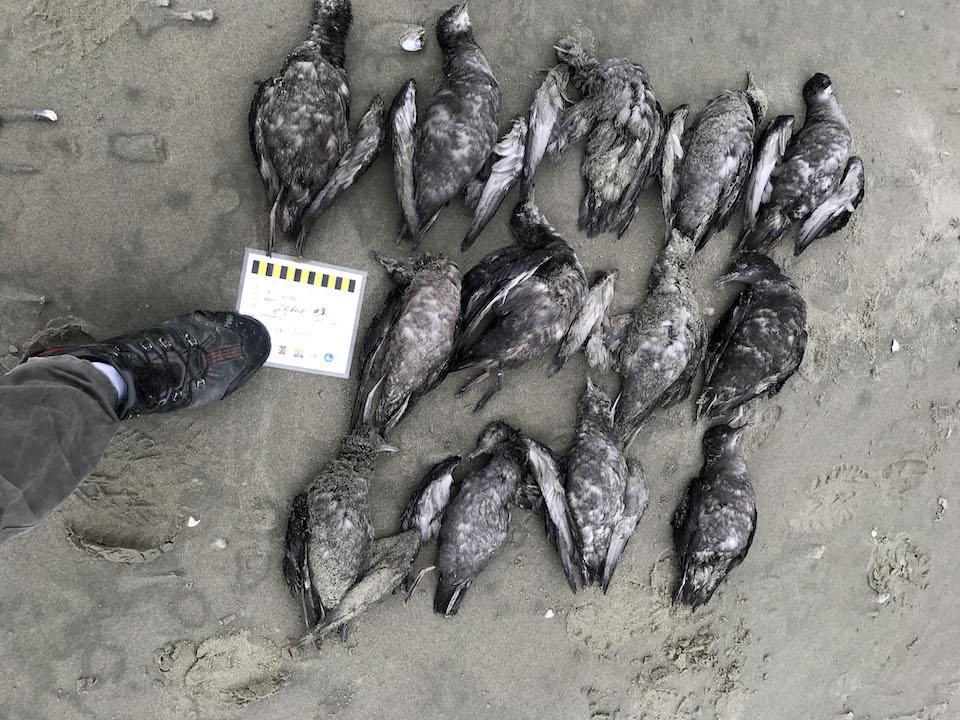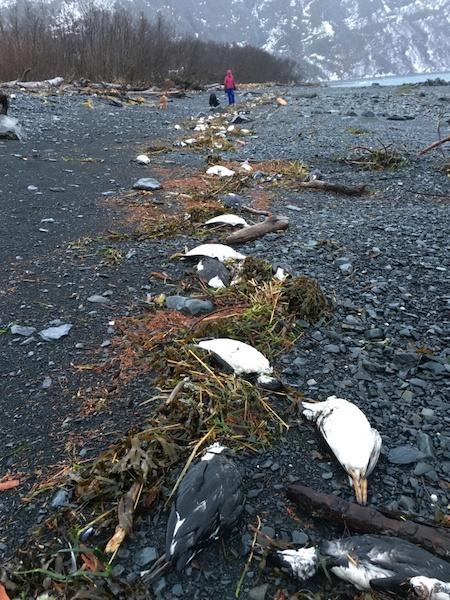
Short-tailed Shearwaters, Ikpek Lagoon, Bering Land Bridge National Preserve/NPS, Jason Tucker
Late last year, thousands of seabirds were reported to have mysteriously died in the northern Bering and Chukchi seas, including near Bering Land Bridge National Preserve. Now scientists believe the culprit in their demise was warming seas.
Historically, seabird die-offs have occurred occasionally in Alaska; however, large die-off events have occurred each year since 2015. Consistently, dead birds examined from the Bering and Chukchi seas during these recent die-offs were determined to have died due to starvation. Seabird carcasses from the 2019 die-off events were collected from multiple locations and sent to the U.S. Geological Survey National Wildlife Health Center for examination and testing. Initial results indicate starvation as the cause of death for most locations.
Now, according to an article in PLOS One, a new analysis of the deaths of unprecedented numbers of common murres between 2015 and 2016 suggests a potential culprit: severely reduced food supplies resulting from unusually elevated sea temperatures. Dr. John Piatt of the U.S. Geological Survey and colleagues present these findings in the open-access journal PLOS ONE on Wednesday.
Last year, from late June to early August, thousands of Short-tailed Shearwaters were reported dead and washing up on beaches in the Bristol Bay, Alaska, region, or observed weak and attempting to feed from salmon gillnets in inland waters. By mid-August, the shearwater die-off had extended north, in smaller numbers but widespread locations, into the northern Bering and Chukchi seas along the coasts of Alaska and the Chukotka Peninsula of Russia. Puffins, murres, and auklets are also being reported, but at much lower numbers than shearwaters.
The PLOS One article notes that from 2014 through 2016, "a large mass of unusually warm seawater nicknamed the 'Blob,' joined later by a strong El Niño, created a severe marine heatwave that stretched from California to Alaska. Within that period, from summer 2015 to spring 2016, an unusual number of dead or dying common murres washed onto Alaska and West Coast beaches. They appeared to have starved, but the underlying cause and its potential connection to the 'Blob' and heatwave has been unclear."
In a bid to figure out what was causing the starvation, Piatt and colleagues analyzed data on dead and dying birds from West Coast bird rehabilitation centers, citizen science beach surveys, community reports, and studies conducted by universities, private organizations, and government entities. They also investigated reproduction rates of murres at breeding colonies.

On Jan. 1 and 2, 2016, 6,540 common murre carcasses were found washed ashore near Whitter, Alaska, translating into about 8,000 bodies per mile of shoreline — one of the highest beaching rates recorded during the mass mortality event/David B. Irons
"The analysis revealed that about 62,000 dead or dying birds washed onto beaches during the die-off event, but carcass recovery estimates suggest that about 1 million died in total," a news release about the article said. "In Alaska, observations of murre carcasses were up to 1,000 times higher than normal. An unprecedented proportion of murre breeding colonies failed to produce any young between 2015 and 2017—the marine heatwave began in August 2014, a summer before this breeding period."
Piatt and colleagues hypothesize that the elevated water temperatures "reduced the quantity and quality of phytoplankton, which in turn reduced quantity and quality of the fish eaten by common murres. At the same time, the warmer waters increased the metabolic needs of larger fish that compete with murres for food."
These forces, the researchers decided, may have caused the observed mass starvation of murres and reduced their reproductive success.
“The unprecedented loss of about a million Common Murre seabirds in the Northeast Pacific during the severe and prolonged marine heatwave of 2014-16 raised a red-flag warning about the state of marine ecosystems on the continental shelf of western North America," the scientists wrote.
As this study demonstrates, the article says, "the murre die-off revealed the onset of a major disruption in the flow of energy through marine food-webs which led ultimately to alarming declines in reproductive output and population size of murres, other seabirds, commercial fish, and great whales during 2016-19."



Add comment